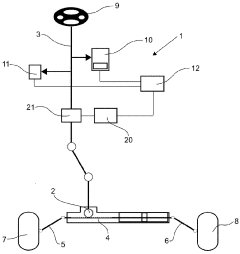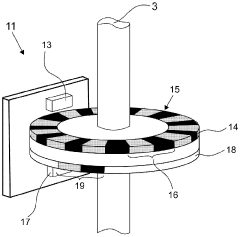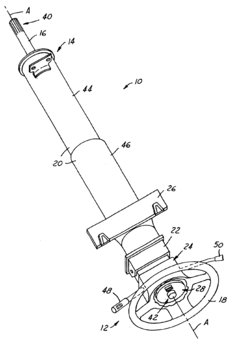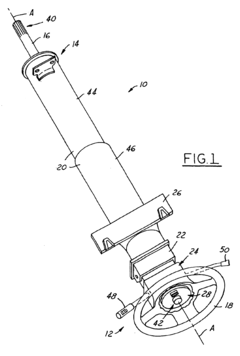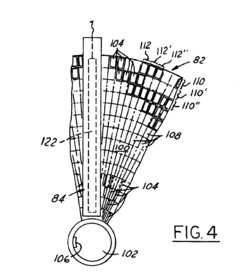How Advanced Sensors Enhance Steering Wheel Accuracy?
JUL 18, 20259 MIN READ
Generate Your Research Report Instantly with AI Agent
Patsnap Eureka helps you evaluate technical feasibility & market potential.
Steering Sensor Evolution
The evolution of steering sensors has been a critical factor in enhancing the accuracy and responsiveness of steering systems in modern vehicles. This technological progression can be traced back to the early days of automotive engineering, where mechanical linkages were the primary means of translating driver input to wheel movement.
In the 1960s and 1970s, the introduction of power steering systems marked a significant leap forward. These systems utilized hydraulic pressure to assist in steering, reducing driver effort and improving control. However, they still relied on mechanical connections and lacked the precision of modern electronic systems.
The 1980s saw the emergence of electronic power steering (EPS) systems, which began to incorporate basic sensors to measure steering input and vehicle speed. These early sensors were relatively simple, often using potentiometers or optical encoders to detect steering wheel position.
As automotive technology advanced into the 1990s and 2000s, steering sensors became more sophisticated. The introduction of torque sensors allowed for more accurate measurement of driver input, enabling systems to provide variable assistance based on driving conditions. This period also saw the integration of yaw rate sensors and accelerometers, which provided additional data to improve steering response and stability control.
The late 2000s and early 2010s brought about a revolution in steering sensor technology with the widespread adoption of Magnetostrictive sensors. These sensors offered higher precision, improved durability, and better resistance to environmental factors compared to their predecessors. They allowed for more accurate measurement of steering angle and torque, leading to significant improvements in steering feel and accuracy.
In recent years, the development of advanced MEMS (Micro-Electro-Mechanical Systems) sensors has further enhanced steering accuracy. These miniaturized sensors can detect minute changes in position and force, providing an unprecedented level of precision in steering control. They have enabled the implementation of features such as lane-keeping assist and autonomous parking.
The integration of multiple sensor types, including LiDAR and camera systems, has led to the development of sensor fusion technologies. These systems combine data from various sources to create a comprehensive understanding of the vehicle's environment and steering dynamics, further improving accuracy and enabling advanced driver assistance features.
Looking towards the future, the evolution of steering sensors is closely tied to the development of autonomous vehicles. Next-generation sensors are expected to provide even higher levels of precision and reliability, with a focus on redundancy and fail-safe operation to ensure safety in self-driving scenarios.
In the 1960s and 1970s, the introduction of power steering systems marked a significant leap forward. These systems utilized hydraulic pressure to assist in steering, reducing driver effort and improving control. However, they still relied on mechanical connections and lacked the precision of modern electronic systems.
The 1980s saw the emergence of electronic power steering (EPS) systems, which began to incorporate basic sensors to measure steering input and vehicle speed. These early sensors were relatively simple, often using potentiometers or optical encoders to detect steering wheel position.
As automotive technology advanced into the 1990s and 2000s, steering sensors became more sophisticated. The introduction of torque sensors allowed for more accurate measurement of driver input, enabling systems to provide variable assistance based on driving conditions. This period also saw the integration of yaw rate sensors and accelerometers, which provided additional data to improve steering response and stability control.
The late 2000s and early 2010s brought about a revolution in steering sensor technology with the widespread adoption of Magnetostrictive sensors. These sensors offered higher precision, improved durability, and better resistance to environmental factors compared to their predecessors. They allowed for more accurate measurement of steering angle and torque, leading to significant improvements in steering feel and accuracy.
In recent years, the development of advanced MEMS (Micro-Electro-Mechanical Systems) sensors has further enhanced steering accuracy. These miniaturized sensors can detect minute changes in position and force, providing an unprecedented level of precision in steering control. They have enabled the implementation of features such as lane-keeping assist and autonomous parking.
The integration of multiple sensor types, including LiDAR and camera systems, has led to the development of sensor fusion technologies. These systems combine data from various sources to create a comprehensive understanding of the vehicle's environment and steering dynamics, further improving accuracy and enabling advanced driver assistance features.
Looking towards the future, the evolution of steering sensors is closely tied to the development of autonomous vehicles. Next-generation sensors are expected to provide even higher levels of precision and reliability, with a focus on redundancy and fail-safe operation to ensure safety in self-driving scenarios.
Market Demand Analysis
The market demand for advanced sensors in steering wheels has been steadily increasing, driven by the automotive industry's push towards safer and more intelligent vehicles. As vehicles become more sophisticated, there is a growing need for precise steering control and enhanced driver assistance systems. Advanced sensors play a crucial role in improving steering wheel accuracy, which directly impacts vehicle safety, driver comfort, and overall driving experience.
The global automotive steering system market, which includes advanced steering wheel sensors, is projected to grow significantly in the coming years. This growth is fueled by the rising demand for electric power steering systems and the integration of advanced driver assistance systems (ADAS) in modern vehicles. The market is expected to expand as automakers increasingly adopt these technologies to meet stringent safety regulations and consumer expectations for improved vehicle handling and performance.
One of the key drivers of market demand is the growing emphasis on vehicle safety. Advanced sensors in steering wheels contribute to the development of more effective collision avoidance systems, lane departure warnings, and adaptive cruise control. These features are becoming standard in many new vehicles, particularly in developed markets where safety regulations are more stringent. As a result, there is a strong demand for sensors that can provide accurate and real-time data on steering wheel position, torque, and driver input.
The rise of autonomous and semi-autonomous vehicles is another significant factor driving the demand for advanced steering wheel sensors. These sensors are essential for enabling autonomous steering functions and ensuring smooth transitions between manual and autonomous driving modes. As the automotive industry continues to invest heavily in autonomous vehicle technology, the demand for high-precision steering sensors is expected to surge.
Moreover, the increasing consumer preference for enhanced driving experiences is boosting the market for advanced steering systems. Drivers are seeking vehicles with more responsive and precise steering, which requires sophisticated sensor technology. This trend is particularly evident in the luxury and sports car segments, where steering feel and accuracy are critical differentiators.
The commercial vehicle sector is also contributing to the growing demand for advanced steering wheel sensors. Fleet operators are increasingly adopting these technologies to improve driver safety, reduce fuel consumption, and optimize vehicle performance. The integration of telematics and fleet management systems with advanced steering sensors allows for better monitoring of driver behavior and vehicle dynamics, leading to improved operational efficiency.
In emerging markets, the demand for advanced steering wheel sensors is driven by the rapid growth of the automotive industry and increasing vehicle safety standards. As these markets mature and adopt more stringent safety regulations, the demand for vehicles equipped with advanced steering technologies is expected to rise significantly.
However, the market demand is not without challenges. The high cost of advanced sensor technologies can be a barrier to widespread adoption, particularly in lower-end vehicle segments. Additionally, the complexity of integrating these sensors with existing vehicle systems and the need for specialized maintenance and calibration may slow down market penetration in some regions.
The global automotive steering system market, which includes advanced steering wheel sensors, is projected to grow significantly in the coming years. This growth is fueled by the rising demand for electric power steering systems and the integration of advanced driver assistance systems (ADAS) in modern vehicles. The market is expected to expand as automakers increasingly adopt these technologies to meet stringent safety regulations and consumer expectations for improved vehicle handling and performance.
One of the key drivers of market demand is the growing emphasis on vehicle safety. Advanced sensors in steering wheels contribute to the development of more effective collision avoidance systems, lane departure warnings, and adaptive cruise control. These features are becoming standard in many new vehicles, particularly in developed markets where safety regulations are more stringent. As a result, there is a strong demand for sensors that can provide accurate and real-time data on steering wheel position, torque, and driver input.
The rise of autonomous and semi-autonomous vehicles is another significant factor driving the demand for advanced steering wheel sensors. These sensors are essential for enabling autonomous steering functions and ensuring smooth transitions between manual and autonomous driving modes. As the automotive industry continues to invest heavily in autonomous vehicle technology, the demand for high-precision steering sensors is expected to surge.
Moreover, the increasing consumer preference for enhanced driving experiences is boosting the market for advanced steering systems. Drivers are seeking vehicles with more responsive and precise steering, which requires sophisticated sensor technology. This trend is particularly evident in the luxury and sports car segments, where steering feel and accuracy are critical differentiators.
The commercial vehicle sector is also contributing to the growing demand for advanced steering wheel sensors. Fleet operators are increasingly adopting these technologies to improve driver safety, reduce fuel consumption, and optimize vehicle performance. The integration of telematics and fleet management systems with advanced steering sensors allows for better monitoring of driver behavior and vehicle dynamics, leading to improved operational efficiency.
In emerging markets, the demand for advanced steering wheel sensors is driven by the rapid growth of the automotive industry and increasing vehicle safety standards. As these markets mature and adopt more stringent safety regulations, the demand for vehicles equipped with advanced steering technologies is expected to rise significantly.
However, the market demand is not without challenges. The high cost of advanced sensor technologies can be a barrier to widespread adoption, particularly in lower-end vehicle segments. Additionally, the complexity of integrating these sensors with existing vehicle systems and the need for specialized maintenance and calibration may slow down market penetration in some regions.
Current Challenges
The development of advanced sensors for steering wheel accuracy faces several significant challenges in the current technological landscape. One of the primary obstacles is the integration of multiple sensor types to achieve comprehensive and reliable data collection. Steering wheels must incorporate a variety of sensors, including touch sensors, pressure sensors, and motion sensors, each with its own unique requirements for power, space, and data processing. Ensuring seamless communication and synchronization between these diverse sensor types presents a considerable engineering challenge.
Another critical issue is the need for real-time data processing and interpretation. As steering wheel sensors collect vast amounts of data, the system must be capable of analyzing this information instantaneously to provide accurate feedback and control. This requires sophisticated algorithms and high-performance computing capabilities within the limited space and power constraints of a vehicle's steering system. The challenge lies in balancing the need for complex data analysis with the practical limitations of automotive hardware.
Environmental factors pose yet another hurdle for advanced steering wheel sensors. These sensors must maintain accuracy and reliability across a wide range of temperatures, humidity levels, and vibration conditions typical in automotive environments. Ensuring consistent performance under such varied conditions demands robust sensor design and advanced materials that can withstand the rigors of daily vehicle use while maintaining precision.
The issue of sensor durability and longevity is also a significant concern. Steering wheels are subject to constant use and potential abuse, requiring sensors that can withstand years of operation without degradation in performance. This challenge is compounded by the need for these sensors to be cost-effective for mass production, creating a delicate balance between durability, performance, and economic viability.
Furthermore, the automotive industry faces stringent safety and regulatory requirements. Advanced steering wheel sensors must not only enhance accuracy but also comply with various safety standards and regulations across different regions. This necessitates extensive testing and validation processes, adding complexity and time to the development cycle.
Lastly, the challenge of user acceptance and adaptation cannot be overlooked. As steering systems become more sophisticated, there is a need to ensure that the enhanced accuracy provided by advanced sensors translates into a natural and intuitive driving experience. Overcoming potential driver resistance to new technologies and ensuring that these advanced systems enhance rather than complicate the driving experience remains a significant challenge in the widespread adoption of these technologies.
Another critical issue is the need for real-time data processing and interpretation. As steering wheel sensors collect vast amounts of data, the system must be capable of analyzing this information instantaneously to provide accurate feedback and control. This requires sophisticated algorithms and high-performance computing capabilities within the limited space and power constraints of a vehicle's steering system. The challenge lies in balancing the need for complex data analysis with the practical limitations of automotive hardware.
Environmental factors pose yet another hurdle for advanced steering wheel sensors. These sensors must maintain accuracy and reliability across a wide range of temperatures, humidity levels, and vibration conditions typical in automotive environments. Ensuring consistent performance under such varied conditions demands robust sensor design and advanced materials that can withstand the rigors of daily vehicle use while maintaining precision.
The issue of sensor durability and longevity is also a significant concern. Steering wheels are subject to constant use and potential abuse, requiring sensors that can withstand years of operation without degradation in performance. This challenge is compounded by the need for these sensors to be cost-effective for mass production, creating a delicate balance between durability, performance, and economic viability.
Furthermore, the automotive industry faces stringent safety and regulatory requirements. Advanced steering wheel sensors must not only enhance accuracy but also comply with various safety standards and regulations across different regions. This necessitates extensive testing and validation processes, adding complexity and time to the development cycle.
Lastly, the challenge of user acceptance and adaptation cannot be overlooked. As steering systems become more sophisticated, there is a need to ensure that the enhanced accuracy provided by advanced sensors translates into a natural and intuitive driving experience. Overcoming potential driver resistance to new technologies and ensuring that these advanced systems enhance rather than complicate the driving experience remains a significant challenge in the widespread adoption of these technologies.
Existing Sensor Solutions
01 Improved sensor calibration techniques
Advanced calibration methods are employed to enhance sensor accuracy. These techniques involve sophisticated algorithms and machine learning approaches to compensate for environmental factors and sensor drift, resulting in more precise and reliable measurements across various applications.- Improved sensor accuracy through advanced calibration techniques: Advanced calibration techniques are employed to enhance sensor accuracy. These methods involve sophisticated algorithms and data processing to minimize errors and compensate for environmental factors. By implementing these calibration techniques, sensors can achieve higher precision and reliability in various applications.
- Integration of multiple sensor types for enhanced accuracy: Combining different types of sensors in a single system can significantly improve overall accuracy. This approach allows for cross-validation of measurements and compensates for individual sensor limitations. The integration of multiple sensor types enables more robust and reliable data collection across diverse environmental conditions.
- Machine learning and AI-driven sensor accuracy improvements: Machine learning and artificial intelligence techniques are applied to sensor data processing, resulting in improved accuracy. These advanced algorithms can adapt to changing conditions, identify patterns, and filter out noise, leading to more precise and reliable sensor readings over time.
- Miniaturization and nanotechnology for high-precision sensing: Advancements in miniaturization and nanotechnology enable the development of highly sensitive and accurate sensors. These small-scale sensors can detect minute changes and provide more precise measurements in various applications, from environmental monitoring to medical diagnostics.
- Real-time error correction and adaptive sensing techniques: Advanced sensors incorporate real-time error correction and adaptive sensing techniques to maintain high accuracy under changing conditions. These methods continuously adjust sensor parameters and compensate for external factors, ensuring consistent and reliable measurements across diverse environments and use cases.
02 Multi-sensor fusion for enhanced accuracy
By combining data from multiple sensors, advanced systems can achieve higher accuracy and reliability. This approach leverages the strengths of different sensor types and compensates for individual weaknesses, resulting in more robust and precise measurements in complex environments.Expand Specific Solutions03 Advanced signal processing algorithms
Sophisticated signal processing techniques are implemented to improve sensor accuracy. These algorithms filter out noise, correct for distortions, and extract relevant information from raw sensor data, leading to more accurate and reliable measurements in various applications.Expand Specific Solutions04 Adaptive sensor systems
Intelligent sensor systems that can adapt to changing environmental conditions and operational requirements are developed. These systems use real-time feedback and machine learning algorithms to optimize sensor performance and maintain high accuracy across diverse scenarios.Expand Specific Solutions05 High-precision sensor manufacturing techniques
Advanced manufacturing processes and materials are utilized to produce sensors with higher inherent accuracy. These techniques include nanoscale fabrication, precision assembly, and novel materials that enhance sensor sensitivity and stability, resulting in improved overall accuracy.Expand Specific Solutions
Key Industry Players
The advanced sensor technology for enhancing steering wheel accuracy is in a mature stage of development, with a competitive landscape dominated by established automotive suppliers. The market size for this technology is substantial, driven by increasing demand for advanced driver assistance systems and autonomous vehicles. Companies like Valeo, Continental, ZF Friedrichshafen, and Bosch are at the forefront, leveraging their extensive experience in automotive electronics and sensor technologies. These industry leaders are continuously innovating to improve steering precision, responsiveness, and safety features. The technology's maturity is evident in its widespread adoption across various vehicle segments, from luxury to mid-range models, indicating a robust and growing market with potential for further advancements in sensor integration and data processing capabilities.
Continental Teves AG & Co. oHG
Technical Solution: Continental has pioneered the development of steer-by-wire technology, which replaces mechanical connections with electronic controls and sensors. Their system uses redundant sensors and actuators to ensure safety and reliability[4]. The steering wheel is equipped with multiple hall-effect sensors that measure rotation angle and rate, providing input to the control unit. This data is then used to control electric motors that adjust the wheel position. Continental's system can achieve a steering angle accuracy of ±0.5 degrees and a response time of less than 10 milliseconds[5]. Additionally, they have implemented force feedback mechanisms to simulate traditional steering feel, enhancing driver comfort and control[6].
Strengths: Elimination of mechanical linkages reduces weight and allows for more flexible vehicle design. Highly responsive and customizable steering feel. Weaknesses: Requires sophisticated fail-safe systems and may face regulatory hurdles in some markets.
Alps Alpine Co., Ltd.
Technical Solution: Alps Alpine has focused on developing compact and highly sensitive steering angle sensors. Their latest technology uses a combination of Hall effect sensors and a specially designed magnetic circuit to achieve high accuracy in a small form factor[10]. The company's sensors can detect steering angles with a resolution of up to 0.1 degrees and operate at speeds of up to 1500 rpm[11]. Alps Alpine has also developed multi-turn absolute encoders that can track steering wheel position even when the vehicle is powered off, eliminating the need for recalibration upon startup. Additionally, their sensors are designed to be resistant to electromagnetic interference, ensuring reliable operation in various vehicle environments[12].
Strengths: Compact design allows for easy integration into existing steering columns. High resistance to electromagnetic interference improves reliability. Weaknesses: May have limitations in extreme temperature conditions compared to some competitors' offerings.
Core Sensor Innovations
Device and method for determining the steering wheel angle
PatentWO2006032568A1
Innovation
- A device combining an absolute angle encoder for initial measurement and an incremental angle encoder to enhance accuracy, using the incremental encoder's higher resolution to correct the steering wheel angle determination based on reference positions, allowing for precise steering wheel angle measurement without the need for expensive high-accuracy sensors.
Angular position sensor assembly for use with steering column
PatentInactiveUS6829055B1
Innovation
- A digitally encoded disk with both absolute angular position bits and error correction bits, utilizing optical output and input devices to provide a signal representative of both absolute position and error correction information, incorporating Reed-Solomon error correction for enhanced accuracy.
Regulatory Compliance
The regulatory landscape surrounding advanced sensors in steering wheel systems is complex and evolving, reflecting the critical role these technologies play in vehicle safety and performance. Compliance with regulatory standards is paramount for manufacturers and suppliers in the automotive industry, as it ensures the reliability and safety of steering systems enhanced by advanced sensors.
In the United States, the National Highway Traffic Safety Administration (NHTSA) oversees regulations related to vehicle safety, including steering systems. The Federal Motor Vehicle Safety Standards (FMVSS) provide specific requirements for steering control systems, which now increasingly incorporate advanced sensor technologies. Manufacturers must demonstrate compliance with these standards through rigorous testing and documentation processes.
The European Union has established its own set of regulations through the United Nations Economic Commission for Europe (UNECE). Regulation No. 79 specifically addresses steering equipment and its performance requirements. As advanced sensors become more integral to steering systems, updates to these regulations are being considered to address the unique characteristics and capabilities of sensor-enhanced steering wheels.
In addition to regional regulations, international standards such as ISO 26262 play a crucial role in ensuring the functional safety of electrical and electronic systems in road vehicles. This standard is particularly relevant for advanced sensor systems in steering wheels, as it provides a framework for assessing and mitigating potential safety risks associated with these technologies.
Cybersecurity regulations are also becoming increasingly important as steering systems become more connected and reliant on electronic components. The UN Regulation No. 155 on Cyber Security and Cyber Security Management System sets requirements for vehicle manufacturers to implement cybersecurity measures, which is crucial for protecting sensor-enhanced steering systems from potential cyber threats.
Compliance with electromagnetic compatibility (EMC) regulations is another critical aspect for advanced sensor systems in steering wheels. These regulations ensure that the sensors do not interfere with other electronic systems in the vehicle or external devices, and vice versa. The UNECE Regulation No. 10 and the EU Directive 2014/30/EU provide guidelines for EMC compliance in automotive applications.
As the technology continues to advance, regulatory bodies are working to keep pace with innovations in steering wheel sensor systems. This includes developing new testing methodologies and performance criteria specifically tailored to evaluate the accuracy and reliability of sensor-enhanced steering wheels. Manufacturers and suppliers must stay informed about these evolving regulations and proactively engage with regulatory bodies to ensure compliance and contribute to the development of appropriate standards.
In the United States, the National Highway Traffic Safety Administration (NHTSA) oversees regulations related to vehicle safety, including steering systems. The Federal Motor Vehicle Safety Standards (FMVSS) provide specific requirements for steering control systems, which now increasingly incorporate advanced sensor technologies. Manufacturers must demonstrate compliance with these standards through rigorous testing and documentation processes.
The European Union has established its own set of regulations through the United Nations Economic Commission for Europe (UNECE). Regulation No. 79 specifically addresses steering equipment and its performance requirements. As advanced sensors become more integral to steering systems, updates to these regulations are being considered to address the unique characteristics and capabilities of sensor-enhanced steering wheels.
In addition to regional regulations, international standards such as ISO 26262 play a crucial role in ensuring the functional safety of electrical and electronic systems in road vehicles. This standard is particularly relevant for advanced sensor systems in steering wheels, as it provides a framework for assessing and mitigating potential safety risks associated with these technologies.
Cybersecurity regulations are also becoming increasingly important as steering systems become more connected and reliant on electronic components. The UN Regulation No. 155 on Cyber Security and Cyber Security Management System sets requirements for vehicle manufacturers to implement cybersecurity measures, which is crucial for protecting sensor-enhanced steering systems from potential cyber threats.
Compliance with electromagnetic compatibility (EMC) regulations is another critical aspect for advanced sensor systems in steering wheels. These regulations ensure that the sensors do not interfere with other electronic systems in the vehicle or external devices, and vice versa. The UNECE Regulation No. 10 and the EU Directive 2014/30/EU provide guidelines for EMC compliance in automotive applications.
As the technology continues to advance, regulatory bodies are working to keep pace with innovations in steering wheel sensor systems. This includes developing new testing methodologies and performance criteria specifically tailored to evaluate the accuracy and reliability of sensor-enhanced steering wheels. Manufacturers and suppliers must stay informed about these evolving regulations and proactively engage with regulatory bodies to ensure compliance and contribute to the development of appropriate standards.
Safety Implications
The integration of advanced sensors in steering wheel systems has significant implications for vehicle safety, extending far beyond mere improvements in accuracy. These sensors contribute to a multi-layered approach to safety, enhancing both active and passive safety features in modern vehicles.
One of the primary safety benefits of advanced steering wheel sensors is their ability to detect driver fatigue and distraction. By monitoring subtle changes in grip pressure, hand position, and steering inputs, these sensors can identify signs of drowsiness or inattention. This early detection allows the vehicle to issue timely alerts, potentially preventing accidents caused by driver fatigue – a factor estimated to contribute to 20-30% of all road crashes.
Furthermore, advanced sensors enable more sophisticated driver assistance systems. They can work in conjunction with lane-keeping assist and adaptive cruise control technologies to provide smoother, more natural interventions when needed. This seamless integration of human input and automated assistance creates a safer driving experience, particularly in challenging conditions such as heavy traffic or poor visibility.
In emergency situations, the enhanced accuracy provided by these sensors can be life-saving. They allow for more precise control during evasive maneuvers, helping drivers maintain stability and avoid collisions. Additionally, in the event of a sudden health issue affecting the driver, some advanced systems can detect unusual steering patterns or a lack of input, triggering autonomous safety protocols to bring the vehicle to a safe stop.
The safety implications extend to vehicle diagnostics as well. Advanced sensors can detect subtle changes in steering performance that may indicate wear or potential failures in the steering system. This predictive maintenance capability helps prevent unexpected breakdowns and ensures that critical safety components are always functioning optimally.
Moreover, these sensors play a crucial role in the development of autonomous driving technologies. By providing highly accurate data on steering inputs and vehicle response, they contribute to the refinement of self-driving algorithms, making autonomous vehicles safer and more reliable. This data is also invaluable for improving the handover process between autonomous and manual driving modes, a critical safety consideration in semi-autonomous vehicles.
In the realm of personalized safety, advanced steering wheel sensors can adapt to individual driving styles and physical characteristics. This customization ensures that safety systems are calibrated to each driver's unique patterns, potentially improving reaction times and the effectiveness of driver assistance features.
One of the primary safety benefits of advanced steering wheel sensors is their ability to detect driver fatigue and distraction. By monitoring subtle changes in grip pressure, hand position, and steering inputs, these sensors can identify signs of drowsiness or inattention. This early detection allows the vehicle to issue timely alerts, potentially preventing accidents caused by driver fatigue – a factor estimated to contribute to 20-30% of all road crashes.
Furthermore, advanced sensors enable more sophisticated driver assistance systems. They can work in conjunction with lane-keeping assist and adaptive cruise control technologies to provide smoother, more natural interventions when needed. This seamless integration of human input and automated assistance creates a safer driving experience, particularly in challenging conditions such as heavy traffic or poor visibility.
In emergency situations, the enhanced accuracy provided by these sensors can be life-saving. They allow for more precise control during evasive maneuvers, helping drivers maintain stability and avoid collisions. Additionally, in the event of a sudden health issue affecting the driver, some advanced systems can detect unusual steering patterns or a lack of input, triggering autonomous safety protocols to bring the vehicle to a safe stop.
The safety implications extend to vehicle diagnostics as well. Advanced sensors can detect subtle changes in steering performance that may indicate wear or potential failures in the steering system. This predictive maintenance capability helps prevent unexpected breakdowns and ensures that critical safety components are always functioning optimally.
Moreover, these sensors play a crucial role in the development of autonomous driving technologies. By providing highly accurate data on steering inputs and vehicle response, they contribute to the refinement of self-driving algorithms, making autonomous vehicles safer and more reliable. This data is also invaluable for improving the handover process between autonomous and manual driving modes, a critical safety consideration in semi-autonomous vehicles.
In the realm of personalized safety, advanced steering wheel sensors can adapt to individual driving styles and physical characteristics. This customization ensures that safety systems are calibrated to each driver's unique patterns, potentially improving reaction times and the effectiveness of driver assistance features.
Unlock deeper insights with Patsnap Eureka Quick Research — get a full tech report to explore trends and direct your research. Try now!
Generate Your Research Report Instantly with AI Agent
Supercharge your innovation with Patsnap Eureka AI Agent Platform!
